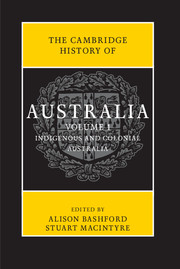Book contents
- Frontmatter
- Contents
- Abbreviations
- List of maps
- List of figures
- List of tables
- Notes on contributors
- Map
- Preface
- Introduction
- PART I
- 1 The past 50,000 years: an archaeological view
- 2 Newcomers, c. 1600–1800
- 3 Convict transportation in global context, c. 1700–88
- 4 The early colonial presence, 1788–1822
- 5 Expansion, 1820–50
- 6 The advent of self-government, 1840s–90
- 7 The gold rushes of the 1850s
- 8 Colonial states and civil society, 1860–90
- 9 Rethinking the 1890s
- 10 Making the federal Commonwealth, 1890–1901
- PART II
- Further reading
- Chronology
- Index
- Frontmatter
- Contents
- Abbreviations
- List of maps
- List of figures
- List of tables
- Notes on contributors
- Map
- Preface
- Introduction
- PART I
- PART II
- Further reading
- Chronology
- Index
8 - Colonial states and civil society, 1860–90
from PART I
Published online by Cambridge University Press: 05 November 2013
- Frontmatter
- Contents
- Abbreviations
- List of maps
- List of figures
- List of tables
- Notes on contributors
- Map
- Preface
- Introduction
- PART I
- 1 The past 50,000 years: an archaeological view
- 2 Newcomers, c. 1600–1800
- 3 Convict transportation in global context, c. 1700–88
- 4 The early colonial presence, 1788–1822
- 5 Expansion, 1820–50
- 6 The advent of self-government, 1840s–90
- 7 The gold rushes of the 1850s
- 8 Colonial states and civil society, 1860–90
- 9 Rethinking the 1890s
- 10 Making the federal Commonwealth, 1890–1901
- PART II
- Further reading
- Chronology
- Index
- Frontmatter
- Contents
- Abbreviations
- List of maps
- List of figures
- List of tables
- Notes on contributors
- Map
- Preface
- Introduction
- PART I
- PART II
- Further reading
- Chronology
- Index
Summary
The first of the gold rushes was the most dramatic. In the decade following the original discoveries, 600,000 immigrants settled in the Australian colonies, taking the non-Aboriginal population to 1,152,000 by 1861; estimates of the Aboriginal population in that year range up to 180,000. While Victoria grew fastest, from 77,000 to 539,000, all the mainland colonies doubled in size. The challenge Victoria faced as its richest alluvial fields were worked out was to stem the outflow of prospectors and consolidate local industries that had sprung up to serve their needs. The other colonies competed for labour and capital to fulfill their own aspirations.
They made rapid strides. Stimulated by a high rate of fertility and further migration, which brought nearly 750,000 additional settlers, the country's population reached 3,174,000 by 1891. Half lived in towns and cities, among which Melbourne (473,000), Sydney (400,000) and Adelaide (117,000) accounted for more than one third of their colonial populations. The consolidation of settlement in the south-east corner of the continent was accompanied by a push into the north: separated from New South Wales in 1859, Queensland's population grew over the three decades from 30,000 to 394,000. Economic progress outstripped the increase in population and gross domestic product increased more than threefold; the annual rate of economic growth averaged 4.8 per cent.
The growth was sustained across the 30 years, making this an epoch of rising prosperity matched only by the quarter-century following World War 2 and the two decades that spanned the end of the twentieth century. As with those subsequent long booms, this one was marked by successful innovation that lifted productivity and augmented living standards so that before 1890 Australians probably enjoyed the highest per-capita income in the world. The improvement of physical conditions, the spread of education and opportunities for personal improvement built confidence in the future.
- Type
- Chapter
- Information
- The Cambridge History of Australia , pp. 189 - 217Publisher: Cambridge University PressPrint publication year: 2013
- 5
- Cited by



